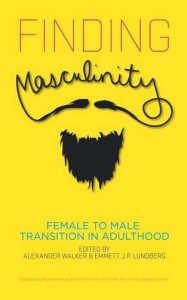Review: Finding Masculinity


What you take away from this book depends on what your motive is for picking it up. It’s a goldmine of information if you want to learn more about what it means to be F to M trans. It must be a feast of recognition if you are trans. For me, it was dropped in my lap at a perfect moment in my life. This is currently a ‘hot topic’ in my immediate environment, resulting in endless discussions that are a peculiar mixture of excitement, concerns, humor, anxiety, crude jokes and desperation.
This book saw the light because the authors realized that there were many pieces of information lacking in available narratives about how others experience transition in different aspects of their daily life, beyond the most-often discussed medical transition. Finding Masculinity attempts to find the answers to questions like ‘how does transitioning to a masculine-identified person affect how we approach the world?, ‘how does this process impact our relationships’, ‘and what about our careers and our families’?
I’m amazed by and thankful for the willingness of transgender people to put themselves out there on the internet via YouTube, FB groups, and in this book. They share their struggles and successes with a mostly ignorant world. But above else with others that have not/only just yet embarked on their personal journey after having walked around with a sense of unease, a feeling of not belonging in the body that’s assigned to them. This book makes crystal clear that for many trans folks the road to becoming the gender they were all along is not without fear and concerns about how coming out as trans will affect their family, friends, health and career.
These are exactly the aspects the authors focus on. In a book that feels longer than its 180 pages due to its information density and the intensity of the shared experiences, the authors have divided Finding Masculinity in multiple sections, namely: introductions, emotional and spiritual transition, family, relationships, medical community and transitioning on the job.
The foreword by Nick Krieger is excellent, and turns out to be an appetiser for what’s to come: a series of well-written engaging stories that are rich in detail. Though it’s not necessary to read these sections in chronological order, it’s probably a good idea to start with a bunch of the introductions that cover early childhood and upbringing, handling strict societal gender roles, (often) coming out as lesbian and figuring out that this doesn’t seem quite right either, and ultimately: finding happiness.
Looking back I can see in sharp and poignant relief the moment in which I was faced with this realization. I was in kindergarten of first grade, happily playing toy monster trucks with some of my male classmates. From atop a small playground above me came a mocking inquiry from three older girls as to why I was playing trucks with boys. The implication of course being that I was a girl, and shouldn’t be acting like a boy. In response to their teasing I gripped my monster truck in hand and defiantly thrust it skyward retorting: ‘Would a girl have this!?” There was a pause, followed by laughter: “You think you’re a boy??”
Sometimes I thought my parents were keeping a secret from me, a secret too controversial for someone my age to understand. I thought they had my penis surgically removed when I was a baby because they already had two boys. In the shower, I would search for the scar, looking to find any evidence to help me understand.
As the blurb mentions, Finding Masculinity is a collection of stories from a small cross section of the transgender male community. If you therefore expect thorough coverage of, for example, sexually fluid trans men, you may end up disappointed. The interviewed men are mostly straight males in their early thirties. Furthermore, all of these men are American, meaning that a good deal of their experiences are culturally determined due to US law, healthcare and procedures, and last but certainly not least: the religious conservatism that luckily plays a minor role in (in my particular case) the Netherlands.
Of course, this inevitably means that if you are looking for specific information on certain aspects of the F to M transition, chances are you will not find it in this book. By no means do I want to downplay the difficulties a waiter or freelance editor may experience when transitioning on the job, but personally, I’d be very interested in how trans men in high-profile positions in the corporate world, and possibly in the public eye, handled their transition. I’m sure they must be out there, but I can also understand that a trans man in the prime of his career is probably less likely to speak openly about such a private matter as transitioning. Which is why I’m not too disappointed that one is not featured in this book.
In the end, many of the experiences regarding transitioning must be universal.
Living out something you’ve spent countless hours daydreaming about and wondering about is an experience that isn’t easily put into words.
 2
2


